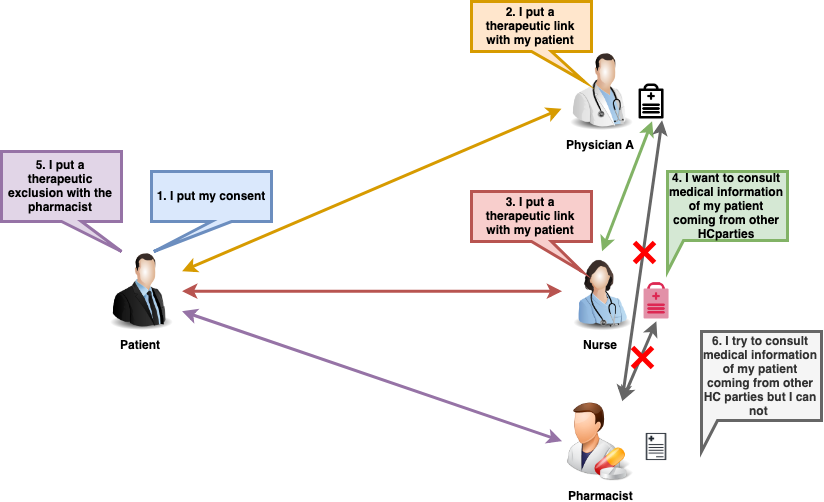Used documentation
| Cookbook/ materials | Version | Location |
|---|---|---|
| eHealthConsent WS Cookbook | 1.9 | |
| KMEHR | - | https://www.ehealth.fgov.be/standards/kmehr/en |
| Jira ticket MHEH-12 | - | MHEH-12 - Getting issue details... STATUS |
| Jira ticket MHEH-13 | - | |
| Jira ticket MHEH-18 | - |
MHEH-18
-
Getting issue details...
STATUS
|
| Jira ticket MHEH-20 | - | MHEH-20 - Getting issue details... STATUS |
| Jira ticket MHEH-26 | - | MHEH-26 - Getting issue details... STATUS |
| Jira ticket MHEH-31 | - | MHEH-31 - Getting issue details... STATUS |
| Jira ticket MHEH-32 | - |
MHEH-32
-
Getting issue details...
STATUS
|
General information
In the figure below, we present a logical view about the relationship between the three basic services of the ehealth platform that are the WS Consent, the Therapeutic link WS, and the Therapeutic exclusion services. A consent can be managed by different types of end-users:
- Health Care (HC) parties: a physician, a pharmacy (it is noteworthy that there is no difference between pharmacy and a pharmacist), Hospital, Dentist, Nurse, Midwife, Health Insurance Organization (HIO), Authorized organization in behalf of a HIO, Group of nurses
- Citizen: a patient, a parent of a patient, a mandatary
A consent may have two types. Indeed, it is called prospective when it is valuable for data posterior to the signing date (i.e. the date that should be taken into account is the ‘medical date’ of the transaction). It is referred to as retrospective in the opposite case. This does not mean that all documents with a medical date anterior to the signing date of the consent will automatically be made available
The Consent service provides four methods (it is noteworthy that in this use case only the GetPatientConsent method is used):
- The "PutPatientConsent" method allows an end-user to declare the patient consent (i.e. make a consent active)
- The "RevokePatientConsent" method enables an end-user to revoke the patient consent (i.e. make a consent inactive)
- The "GetPatientConsent" method allows an end-user to consult information about a consent and to check whether its status (i.e. active or inactive)
- The "GetPatientConsentStatus" method is similar as the "GetPatientConsent" method with the status of the consent returned in the response message.
Basic flow
| Flow | Specification | ||
|---|---|---|---|
Use case ID | ATH-UC-12-BF | ||
Use case name | Consult an active consent of a patient | ||
Actors |
| ||
Short Description | In order to consult the consent of a patient, | ||
| Priority | 1 (High) Must have: The system must implement this goal/ assumption to be accepted. | ||
Pre-Conditions |
| ||
Post-Conditions |
| ||
Steps (basic flow) | 0 | ||
| 1 | |||
2 | |||
| 3 | |||
4 | |||
| 5 | |||
6 | |||
7 | |||
| 8 | |||
| 9 | |||
| 10 | |||
| 11 | |||
Exceptions (exception flows) |
| ||
Frequency |
| ||
Alternative flow 1
| Flow | Specification | ||
|---|---|---|---|
Use case ID | ATH-UC-12-AF-01 | ||
Use case name | Consult an inactive consent of a patient | ||
Actors |
| ||
Short Description | In order to consult the consent of a patient, | ||
| Priority | 1 (High) Must have: The system must implement this goal/ assumption to be accepted. | ||
Pre-Conditions |
| ||
Post-Conditions | |||
Steps (basic flow) | 0 | ||
| 1 | |||
2 | |||
| 3 | |||
4 | |||
| 5 | |||
6 | |||
7 | |||
| 8 | |||
| 9 | |||
| 10 | |||
| 11 | |||
Exceptions (exception flows) |
| ||
Frequency |
| ||
Alternative flow 2
| Flow | Specification | ||
|---|---|---|---|
Use case ID | ATH-UC-12-AF-02 | ||
Use case name | Unsuccessful completion | ||
Actors |
| ||
Short Description | In order to consult the consent of a patient, | ||
| Priority | 1 (High) Must have: The system must implement this goal/ assumption to be accepted. | ||
Pre-Conditions |
| ||
Post-Conditions | |||
Steps (basic flow) | 0 | ||
| 1 | |||
2 | |||
| 3 | |||
4 | |||
| 5 | |||
6 | |||
7 | |||
| 8 | |||
| 9 | |||
| 10 | |||
| 11 | |||
Exceptions (exception flows) |
| ||
Frequency |
| ||
